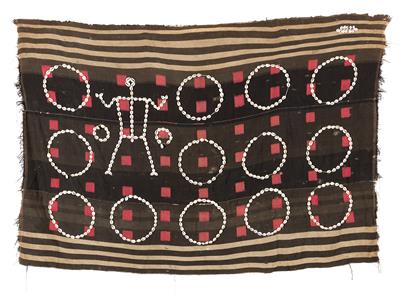Naga, India, Burma: A typical scarf for victorious Naga warriors. Depicting a human figure and 15 circles sewn out of cowrie shells.
Naga, India, Burma: A typical scarf for victorious Naga warriors. Depicting a human figure and 15 circles sewn out of cowrie shells.

This type of recognition scarf for men is one of the best known examples of the diverse textile culture of the Naga (see also cat. no. 171). Prestige fabrics, such as this one, are chiefly worn by the men of the Sema, Chang, and Sangtam Naga subgroups. The scarf is made up of three bands of fine handwoven cotton sewn together. It is black in colour but has along its upper and lower edges black horizontal stripes (on light-coloured background). 9 vertical rows of red squares are interwoven (insert-woven) into the central black surface. Some of the specialist literature affirms a (disputed) connection between these squares and dog years. A male figure made of cowrie shells is sewn into the fabric of the left half of this Naga scarf. Immediately to the left and right of this figure are two small circles. 13 more, larger ones made of sewn white cowries are distributed throughout the central black expanse — in strict vertical and horizontal rows. Preserved in the upper right corner of the scarf is a closed group of twelve sewn cowrie shells. This serves as a head-tally, so to speak, for the man to whom this scarf belongs (i.e. keeping count of how many heads he has felled). The present Naga fabric is unusually old, showing clear signs of protracted use and minor age-related damage: mended spots, small delicate holes and a few missing cowries. Importantly, Naga scarfs of such age are nearly impossible to find today. Dimensions: c. 100 cm x 150 cm. Between c. 1900 and the first third of the 20th century. (ME)
Provenance: Austrian Private Collection.
Lit.: 'The Nagas' by Julian Jacobs, ill. p. 297.
Esperto: Prof. Erwin Melchardt
 Prof. Erwin Melchardt
Prof. Erwin Melchardt
+43-1-515 60-465
erwin.melchardt@dorotheum.at
02.11.2015 - 14:00
- Prezzo di partenza:
-
EUR 300,-
Naga, India, Burma: A typical scarf for victorious Naga warriors. Depicting a human figure and 15 circles sewn out of cowrie shells.
This type of recognition scarf for men is one of the best known examples of the diverse textile culture of the Naga (see also cat. no. 171). Prestige fabrics, such as this one, are chiefly worn by the men of the Sema, Chang, and Sangtam Naga subgroups. The scarf is made up of three bands of fine handwoven cotton sewn together. It is black in colour but has along its upper and lower edges black horizontal stripes (on light-coloured background). 9 vertical rows of red squares are interwoven (insert-woven) into the central black surface. Some of the specialist literature affirms a (disputed) connection between these squares and dog years. A male figure made of cowrie shells is sewn into the fabric of the left half of this Naga scarf. Immediately to the left and right of this figure are two small circles. 13 more, larger ones made of sewn white cowries are distributed throughout the central black expanse — in strict vertical and horizontal rows. Preserved in the upper right corner of the scarf is a closed group of twelve sewn cowrie shells. This serves as a head-tally, so to speak, for the man to whom this scarf belongs (i.e. keeping count of how many heads he has felled). The present Naga fabric is unusually old, showing clear signs of protracted use and minor age-related damage: mended spots, small delicate holes and a few missing cowries. Importantly, Naga scarfs of such age are nearly impossible to find today. Dimensions: c. 100 cm x 150 cm. Between c. 1900 and the first third of the 20th century. (ME)
Provenance: Austrian Private Collection.
Lit.: 'The Nagas' by Julian Jacobs, ill. p. 297.
Esperto: Prof. Erwin Melchardt
 Prof. Erwin Melchardt
Prof. Erwin Melchardt
+43-1-515 60-465
erwin.melchardt@dorotheum.at
|
Hotline dell'acquirente
lun-ven: 10.00 - 17.00
kundendienst@dorotheum.at +43 1 515 60 200 |
| Asta: | Tribal Art |
| Tipo d'asta: | Asta in sala |
| Data: | 02.11.2015 - 14:00 |
| Luogo dell'asta: | Wien | Palais Dorotheum |
| Esposizione: | 28.10. - 02.11.2015 |
